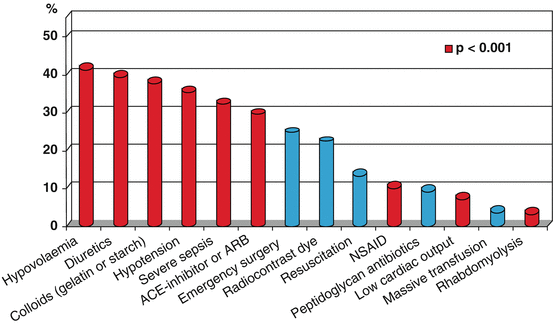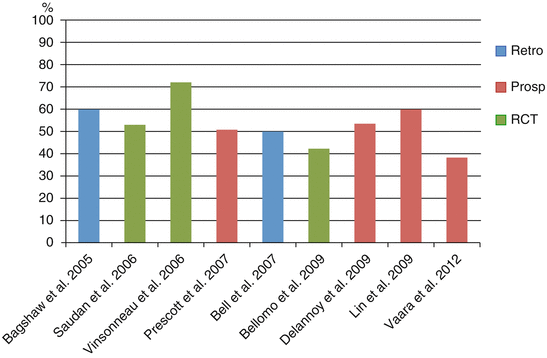Fig. 2.1
Proportion of patients (%) with different acute kidney injury (AKI) stages, according to the recent new classifications (RIFLE/AKI/KDIGO)
Plausible explanations for differences in reported incidences between studies are differences in study designs (retrospective vs. prospective), study populations/case mix, inclusion of urine output criteria, sample sizes and variety in observation periods. Large, multicentre retrospective registry studies comprising more than 10,000 patients have reported incidences from 22 % [13] to 57.0 % [14]. Only few prospective studies [4, 8, 15, 16, 19] have been published, the largest of them including 2,901 patients [4].
Importantly, in only half of the abovementioned studies, both Cr and urine output criteria were included in the definition [4, 6, 8, 10, 11, 15, 16, 19]. The observation period for development of AKI varied from 24 h [10] to the entire hospital stay [6].
2.2 Risk Factors Associated with AKI
Several different predisposing factors and transient insults may affect the kidneys and lead to AKI. The risk for each patient to develop AKI is dependent first on chronic conditions and patient-related factors and second on type and intensity of acute exposures and insults [20]. The most relevant risk factors associated with AKI are summarized in Table 2.1. Estimating an individual absolute risk for AKI is challenging, and attempts to develop risk-prediction scores exist, but are mostly limited to patients with contrast media administration [21] or those after cardiac surgery [22].
Table 2.1
Risk factors associated with AKI
Predisposing factors/chronic diseases |
Advanced age |
Gender |
Black race |
Chronic kidney disease |
Diabetes mellitus |
Heart failure |
Pulmonary disease |
Chronic liver disease and/or complications of portal hypertension |
Proteinuria |
Hypertension |
Coronary artery disease |
Peripheral vascular disease |
Malignancy |
Genetic factors |
Acute diseases/drugs |
Severe sepsis |
Trauma |
Any critical illness |
Hypovolemia |
Hypotension |
Anaemia |
Any major surgery, e.g. cardiac surgery |
Radiocontrast media |
Fluid overload |
Synthetic colloids |
Chloride-rich solutions (i.e. 0.9 % saline) |
Drug toxicity, drug interaction or nephrotoxic medication: |
ACE inhibitors, acyclovir, aminoglycosides, amphotericin, NSAIDs, diuretics, aspirin, metformin, methotrexate, statins |
2.2.1 Predisposing Factors/Chronic Diseases
The incidence of AKI is increasing with advanced age [11, 13, 15, 16, 21, 23] – up to 45 % in ICU patients over 80 years [4]. Conflicting data relate gender to AKI – in some studies female gender [24, 25], but in some studies male gender [26, 27] has been overrepresented [16].Chronic kidney disease (CKD) is by far the most relevant predisposing susceptibility for increased risk for development of AKI [4, 6, 11, 23, 26–28], even with a minimal elevation in creatinine values. Proteinuria per se (with an eGFR >60 mL/min/1.73 m2) carries an adjusted relative risk of 4.4 for AKI [5]. Among the most common diseases at the population level which predispose to AKI are diabetes mellitus [15, 21, 23, 25, 27], heart failure [23, 26, 27], hypertension [27], pulmonary disease [23, 25] and liver disease [13, 23, 27]. Patients with malignant conditions have a higher risk of AKI in the ICU [24, 25] which may be related to either direct invasion to the kidneys, or via modifiable additional factors, such as severe sepsis or nephrotoxic chemotherapeutic agents.
2.2.2 Acute Diseases/Drugs
Sepsis is the most important factor associated with AKI. Up to 50 % of AKI cases are related to sepsis [29–31]. In addition to sepsis, other forms of critical illness, such as major trauma [26] may lead to severe hypovolemia [32] or sustained hypotension [33, 34] predisposing to AKI. Colloids are disadvantageous for the kidneys. Several studies have confirmed that the use of hydroxyethyl starch in critically ill patients, in particular in septic states, increase the risk for AKI and the risk for RRT. The clinical evidence to date, linking gelatin or albumin to increased risk for AKI is inconclusive. Excessive fluid overload has been acknowledged as an independent risk factor for AKI and adverse outcome [35].
Any emergency [23, 27] or major surgery [27], especially cardiac surgery with cardiopulmonary bypass exposure predisposes to AKI due to potential changes in hemodynamics, intravascular volume, delivery of oxygen and the systemic inflammation reaction (systemic inflammatory response syndrome, SIRS) caused by the surgery.
Radiocontrast media and multiple drugs are known to be nephrotoxic. Up to one-fourth of severe AKI cases are estimated to be related to drug toxicity [30]. CKD, sepsis, liver failure, heart failure and malignancies as comorbidities increase the risk for drug-induced kidney injury [36].
Due to the multifactorial etiology of AKI, most patients who develop AKI have several factors predisposing to AKI simultaneously or temporally over time (Fig. 2.2). In the FINNAKI study, a large prospective observational study, only pre-ICU hypovolemia (odds ratio, OR 2.2), pre-ICU use of diuretics (OR 1.7), colloid use (OR 1.4) and chronic kidney disease (OR 2.6, 95 % CI 1.9–3.7) were independently associated with the development of AKI [4].


Fig. 2.2
Proportion of AKI patients (%) with different predisposing factors preceding ICU admission. Factors more common in AKI patients compared to patients without AKI (p < 0.001) with red colour [4]
2.3 Outcomes of AKI Patients
2.3.1 Hospital Mortality
Regrettably most of the AKI studies have focused on short-term mortality. ICU mortality is generally accepted as unreliable due to differences in discharge and end-of-life policies. Hospital mortality may also be biased, and thus variable, due to differences in discharging patients to rehabilitation centres or other hospitals. The reported hospital mortality of AKI patients has varied between 13.3 % [6] and 49.1 % [15] in ten studies [4, 6, 7, 9–12, 15, 18, 19] (Table 2.2). Differences in study designs and patient populations/case mix explain some of the variation. Studies do not consistently report severity scores, but on the basis of the given SAPS II points there was a large variation in disease severity among ICU patients.
Table 2.2
Hospital and 90-day mortality in patients with acute kidney injury classified according to the new definitions (RIFLE, AKIN, KDIGO)
Author, year | Design | Criteria | Number of patients | AKI | Stage 3/RIFLE F | AKI |
|---|---|---|---|---|---|---|
Hospital mortality (%) | Hospital mortality (%) | 90-day mortality (%) | ||||
Åhlström, 2006 [19] | Prospective, single centre | RIFLE Cr + UO | 658 | 16.7 | 23.0 | – |
Hoste, 2006 [6] | Retrospective, single centre | RIFLE Cr + UO | 5,383 | 13.3 | 26.3 | – |
Ostermann, 2007 [7] | Retrospective, multicentre | RIFLE Cr | 41,972 | 36.1 | 56.8 | – |
Ostermann, 2008 [9] | Retrospective, multicentre | AKIN Cr | 22,303 | 40.4 | 57.9 | – |
Bagshaw, 2008 [10] | Retrospective, multicentre | RIFLE Cr | 120,123 | 24.5 | 32.6 | – |
Lopes, 2008 [11] | Retrospective, single centre | RIFLE Cr + UO | 662 | 41.3 | 55.0 | – |
Joannidis, 2009 [12] | Retrospective, multicentre | AKIN Cr | 14,356 | 36.4 | 41.2 | – |
Medve, 2011 [15] | Prospective, multicentre | AKIN Cr + UO | 459 | 49.1 | 73.5 | – |
Sigurdsson, 2012 [18] | Retrospective, single centre | RIFLE Cr | 1,012 | 37.6 | 51.0 | – |
Nisula, 2013 [4] | Prospective, multicentre | KDIGO Cr + UO | 2,901 | 25.6 | 32.2 | 33.7 |
2.3.2 Long-Term Fixed-Time Mortality (90 Days, 6 Months)
The only study with a fixed long-term mortality reported the 90-day mortality rate for AKI patients as 33.7 % [4]. Two prospective studies have reported the 6-month mortality rates of 46.5 % [37] and 35.3 % [38], and two retrospective studies as 58.5 % [39] and 38.0 % [40]. The survival curves of AKI patients [38, 41] suggest that most of deaths among AKI patients occur within 60 days, and so the follow up of 60–90 days would be adequate for a reliable analysis of mortality rate. The mortality rates from different studies for RRT-treated AKI-patients are presented in Fig. 2.3.


Fig. 2.3
90-day mortality (%) in patients with severe AKI who received renal replacement therapy (RRT)
2.3.3 Trends in Mortality
2.3.4 Factors Associated with Mortality
Pre-existing co-morbidities, such as diabetes [45] and CKD [7, 10], and advanced age [46] increase the mortality rate. Fluid overload [47, 48] and hydroxyethyl starch use [49] are associated with excess mortality. Additionally, delay in ICU admission [30, 46], use of mechanical ventilation [30], sepsis [45] and severity of illness and number of organ failures [45] have been associated with increased mortality in AKI patients. Variations in the severity of illness plausibly have an effect on not only the incidence of AKI, but also mortality. RIFLE or AKIN stages, representing worsening severity of AKI, have been independently associated with mortality in most studies [6–12, 15, 18, 19]. Furthermore, even mild stages of AKI have been associated with increased mortality [6]. Most recently, there was a linear increase in 90-day mortality according to the advancing KDIGO stages: from 16.6 % without AKI to 29.3 % in stage 1, 34.1 % for stage 2 and 39.0 % for stage 3 AKI [4].
< div class='tao-gold-member'>
Only gold members can continue reading. Log In or Register to continue
Stay updated, free articles. Join our Telegram channel

Full access? Get Clinical Tree





